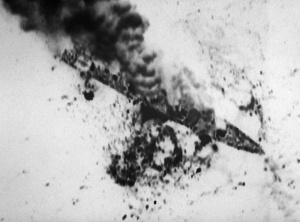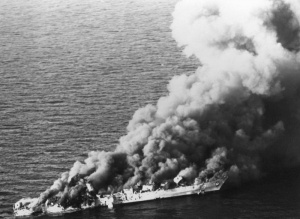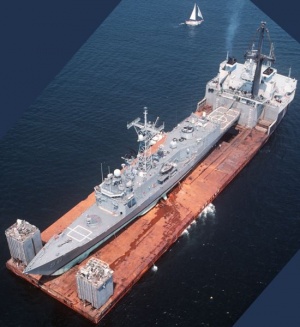Operation Preying Mantis
Operation Praying Mantis was the April 18, 1988 action waged by U.S. naval forces in retaliation for the Iranian mining of the Persian Gulf and the subsequent damage to an American warship.
On April 14, the guided missile frigate USS Samuel B. Roberts struck a mine while sailing in the Gulf as part of Operation Earnest Will, the 1987-88 convoy missions in which U.S. warships escorted reflagged Kuwaiti oil tankers to protect them from Iranian attacks. The explosion put a 25-foot hole in the Roberts' hull and nearly sank it. But the crew saved their ship with no loss of life, and Roberts was towed to Dubai on April 16.
After the mining, U.S. Navy divers recovered other mines in the area. When the serial numbers were found to match those of mines seized along with the Iran Ajr the previous September, U.S. military officials planned a retaliatory operation against Iranian targets in the Gulf.
The battle, the largest for American surface forces since World War II,[1] sank two Iranian warships and as many as six armed speedboats. It also marked the first surface-to-surface missile engagement in U.S. Navy history.
The attack by the U.S. helped pressure Iran to agree to a ceasefire with Iraq later that summer, ending the eight-year conflict between the Persian Gulf neighbors.

THE BATTLE[edit]
On April 18, 1988, the Americans responded with several groups of surface warships, plus aircraft from the carrier USS Enterprise. The action began with coordinated strikes by two surface groups. One group, consisting of two destroyers and the amphibious transport dock USS Trenton, attacked the Sassan oil platform while the other, which included a guided missile cruiser and two frigates, attacked the Sirri oil platform. U.S. Marines from Marine Air-Ground Task Force (MAGTF) 2-88 fast-roped onto the Sassan platform, gathered intelligence, and set explosives to disable it.
Iran responded by dispatching Boghammar speedboats to attack various targets in the Persian Gulf, including an American-flagged supply ship and a Panamanian-flagged ship. After these attacks, A-6E Intruder aircraft from VA-95 were vectored in on the speedboats by an American frigate. The two aircraft, piloted by Lieutenant Commander James Engler and Lieutenant Paul Webb dropped Rockeye cluster bombs on the speedboats, sinking one and damaging several others.
Action continued to escalate. Joshan, an Iranian Combattante II Kaman-class fast attack craft, challenged USS Wainwright (CG-28) and her surface group, firing a Harpoon missile at them. The USS Simpson (FFG-56) responded to the challenge by firing four Standard missiles, while USS Wainwright (CG-28) followed with two Standard missiles. After damage assessment of Joshan, USS Bagley (FF-1069) fired one Harpoon missile at Joshan, however Joshan's superstructure had been destroyed by the previous attacks, so the missile did not strike the target. The three ships of Surface Action Group Charlie closed on the Joshan destroying it with naval gunfire.
Fighting continued when the Iranian frigate Sahand departed Bandar Abbas and challenged elements of an American surface group. She was observed by two VA-95 A-6Es while they were flying surface combat air patrol for USS Joseph Strauss (DDG-16).

Iranian frigate IS Sahand (74) burning on April 18, 1988 after being attacked
Sahand launched missiles at the A-6Es, and the Intruders replied with launches of two Harpoons and four laser-guided Skipper bombs. This was followed by a Harpoon firing from Joseph Strauss. The weapons delivered against Sahand were successful. Fires blazing on Sahand's decks eventually reached her magazines, resulting in an explosion that led to her sinking.
Despite the loss of Sahand, one of Iran's most modern ships, the Iranian navy continued to fight. A sister ship, Sabalan, departed her port for operations in the Persian Gulf. She fired on several A-6Es from VA-95 with a surface-to-air missile. One of the Intruders piloted by Lieutenant Commander James Engler responded with a laser-guided bomb that scored a direct hit on Sabalan and stopped her dead in the water. The Iranian frigate was taken in tow by an Iranian tug with the stern partially submerged. VA-95's aircraft, as ordered, did not continue the attack. LCDR Engler was awarded the Distinguished Flying Cross by Admiral Crowe, Chairman of the Joint Chiefs of Staff, for these combat actions against the Sabalan and the Iranian gunboats.
AFTERMATH[edit]
By the end of the operation elements of the American fleet had damaged Iranian naval and intelligence facilities on two inoperable oil platforms in the Persian Gulf, and sank at least six armed Iranian speedboats. Sabalan was repaired in 1989 and has since been upgraded, and is still in service with the Iranian navy. In short, Iran lost one major warship and a smaller gunboat. Damage to the oil platforms was eventually repaired and they are now back in service.
The U.S. side suffered two casualties: the aircrew of a Marine Corps AH-1T Sea Cobra helicopter gunship. The Cobra, attached to the USS Trenton, was flying reconnaissance from the Wainwright and crashed sometime after dark about 15 miles southwest of Abu Musa island. The bodies of Capt. Stephen C. Leslie, 30, of New Bern, N.C., and Capt. Kenneth W. Hill, 33, of Thomasville, N.C., were recovered by Navy divers in May, and the wreckage of the helicopter was raised later that month. Navy officials said it showed no sign of battle damage, though the aircraft could have crashed while trying to evade Iranian fire.
The guided missile cruiser USS Vincennes was called to protect the extraction of the Roberts and arrived a month later. The heightened tensions contributed to the crew of the Vincennes mistakenly shooting down a commercial airliner on a routine flight, Iran Air Flight 655, killing all 290 crew and passengers on July 3, less than 2 months after their arrival.
Operation Praying Mantis is one of five American naval engagements cited by United States Naval Academy Prof. Craig L. Symonds in his book Decision at Sea (2005) as being decisive in establishing U.S. naval superiority. The others were the Battle of Lake Erie (1813), the Battle of Hampton Roads (1862), the Battle of Manila Bay (1898), and the Battle of Midway (1942).
On November 6, 2003 the International Court of Justice dismissed Iran's claim for reparation against the United States for breach of the 1955 Treaty of Amity between the two countries. The court also dismissed a counter-claim by the United States, also for reparation for breach of the same treaty. As part of it's finding the court did note that "the actions of the United States of America against Iranian oil platforms on 19 October 1987 (Operation Nimble Archer) and 18 April 1988 (Operation Praying Mantis) cannot be justified as measures necessary to protect the essential security interests of the United States of America."[2]

COMMENTS BY KEN[edit]
The response of the disUnited Nations and by the International Court of inJustice are only two examples in the long and tiresome list of anti-Americanism that can be found around the world. Had any of the pinheads in either organization spent any time in the Gulf of Hormuz or the Persian Gulf like I did, they might have possibly been a position to render a fair judgment on this incident.
However as usual these supposed 'intellectual giants' sat in their air conditioned offices, in their silk suits, in Geneva and New York, while people like me were fighting heat stroke in one hundred plus degree temperatures at one hundred percent humidity. We were the ones dodging mines, daily rocket attacks and as usual, we’re the ones that the fingers get pointed at.
Needless to say I find it very difficult to do anything other than laugh at the UN and other world organizations. It’s impossible to take such groups seriously when they operate on a level that is so profoundly ignorant that one wonders how these people even find there way out of bed in the morning, let alone make it to their offices each day.
It is also necessary to point out that our military actions on that day were not specifically to protect our national interests as the court erroneously states. Operation Earnest Will was taking place at the blessing of the UN (for whatever that’s worth) and at the request of the dozens of nations around the world who depend on the oil which flows directly from the Gulf of Hormuz and into the Persian Gulf. Ships from the Navy’s of England, France, Spain, Germany, Saudi Arabia and Qatar, to name just a few also took part in this Operation.
Due to my direct participation in this operation I was awarded with a Meritorious Unit Commendation and an Armed Forces Expeditionary Medal.
US NAVAL ORDER OF BATTLE[edit]
Surface Action Group Bravo
• USS Merrill (DD-976) - destroyer
• USS Lynde McCormick (DDG-8) - guided missile destroyer
• USS Trenton (LPD-14) - amphibious transport dock
• Marine Air-Ground Task Force (MAGTF) 2-88 Surface Action Group Charlie
• USS Wainwright (DLG/CG-28) - guided missile cruiser
• USS Bagley (FF-1069) - frigate
• USS Simpson (FFG-56) - guided missile frigate
• SEAL platoon
Surface Action Group Delta
• USS Jack Williams (FFG-24) - guided missile frigate
• USS O'Brien (DD-975) - destroyer
• USS Joseph Strauss (DDG-16) - guided missile destroyer Air support
• Elements of Air Wing 11 operating from aircraft carrier USS Enterprise (CVN-65)